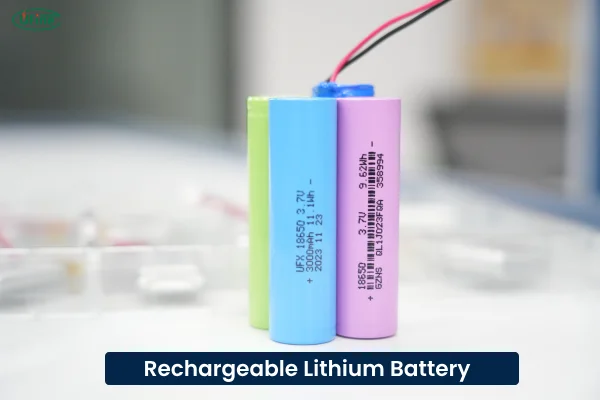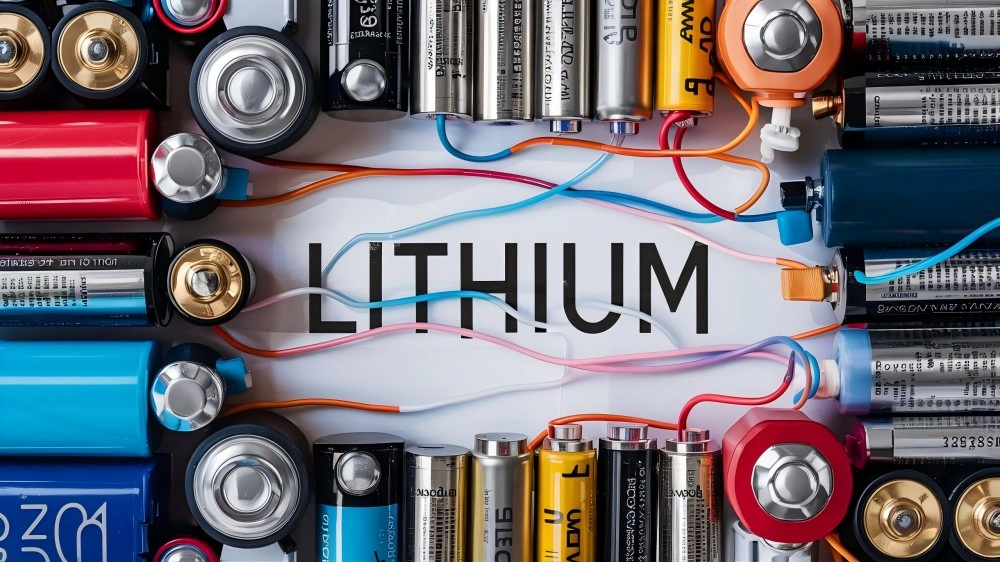Part 1: Are All Lithium-Ion Batteries Rechargeable?
Not all lithium batteries are designed to be rechargeable. Lithium batteries are mainly divided into two categories: rechargeable and non-rechargeable. Rechargeable batteries include lithium-ion (Li-ion) and lithium polymer (LiPo) batteries.
Non-Rechargeable Batteries (Primary Batteries)

Non-rechargeable batteries, or primary batteries, can only convert chemical energy into electrical energy once. They cannot convert electrical energy *back* into chemical energy, which means they have very limited or no recharging capability. Because they contain lithium metal, non-rechargeable batteries cannot be recharged once depleted and can only be recycled.
Rechargeable Lithium Batteries (Secondary Batteries)

Rechargeable batteries are also known as secondary batteries (or storage batteries). These batteries convert electrical energy into chemical energy, storing it for later use. When needed, the stored chemical energy is converted back into electrical energy. Rechargeable batteries can be charged and discharged multiple times.
Lithium-Ion and Lithium Polymer Batteries
Lithium-ion batteries are widely used due to their high capacity, long lifespan, and reliable safety. They are commonly found in mobile electronic devices and electric vehicles.
Lithium polymer batteries have higher capacity, lighter weight, and are also considered safer, making them a promising direction for future development.
Part 2: How Do Rechargeable Batteries Work?
The charging process of a lithium battery is divided into three stages: pre-charge mode, fast charge mode, and constant voltage mode.
Lithium battery charging uses a constant-current/constant-voltage (CC/CV) method, typically controlled by an integrated circuit (IC).
Charging Process
- Pre-charge Mode: When the battery voltage is below 3V, pre-charging begins with a low current, typically one-tenth of the standard charging current.
- Fast Charge Mode: The battery then enters the fast-charge phase, charging at a constant current until it reaches 4.20V.
- Constant Voltage Mode: Once the voltage reaches 4.20V, the charging process switches to constant-voltage mode, maintaining 4.20V while the charging current gradually decreases.
Part 3: Types of Non-Rechargeable Lithium Batteries and Their Applications
What are Non-Rechargeable Lithium Batteries?
Non-rechargeable lithium batteries are batteries that cannot be recharged after their energy is depleted.
Common types of non-rechargeable lithium batteries include lithium-manganese dioxide, lithium-thionyl chloride, and lithium composite batteries.
1. Lithium-Manganese Dioxide (Li-MnO₂)
- Voltage: 3V
- Applications:
- Cameras
- LED flashlights
- Watches
- Keychains
- Medical devices
- Characteristics: High energy density, long shelf life, and reliable performance over a wide temperature range.
2. Lithium-Thionyl Chloride (Li-SOCl₂)
- Voltage: 3.6V
- Applications:
- Electric meters
- Sensors
- Military equipment
- Industrial electronics
- Characteristics: It has an extremely long shelf life (10-20 years) and can operate in extreme temperatures (-55°C to 150°C). Its high energy density makes it ideal for low-power, long-term applications.
3. Lithium-Iron Disulfide (Li-FeS₂)
- Voltage: 1.5V
- Applications:
- Digital cameras
- Toys
- Flashlights
- Portable electronics
- Characteristics: Lightweight, has high energy density, can directly replace standard alkaline batteries in many applications, and has good low-temperature performance.
4. Lithium-Carbon Monofluoride (Li-CFx)
- Voltage: 3V
- Applications:
- Medical devices (e.g., pacemakers)
- Electric meters
- Memory backup in electronic devices
- Characteristics: Offers extremely high energy density and long-lasting performance.
Lithium Battery Overview
1. Types of Primary Lithium Batteries
1.1. Lithium Manganese Dioxide Batteries (Li-MnO2)
- Voltage: 3V
- Applications:
- Military and aerospace sectors
- Medical devices
- Industrial applications
- Characteristics:
- Long shelf life
- High energy density
- Stable performance over extended periods
- High current pulse capability
1.2. Lithium Thionyl Chloride Batteries (Li-SOCl2)
- Voltage: 3.6V
- Applications:
- Military
- Aerospace
- Smart meters
- Automotive electronics
- Characteristics:
- Excellent energy density
- Good performance in extreme temperatures
- Long shelf life
- Typically used in low-power, high-performance applications
1.3. Lithium Iron Disulfide Batteries (Li-FeS2)
- Voltage: 1.5V
- Applications:
- Consumer electronics
- High-performance flashlights
- Camera batteries
- Characteristics:
- High power output
- Reliable performance under various conditions
- Long shelf life
- Widely used in everyday consumer goods
1.4. Lithium Copper Oxide Batteries (Li-CuO)
- Voltage: 1.5V
- Applications:
- Military and aerospace sectors
- Characteristics:
- High capacity
- Suitable for professional and niche applications with low to medium energy consumption
1.5. Lithium Polycarbon Monofluoride Batteries (Li-(CF)n)
- Voltage: 2.8–3.0V
- Applications:
- Medical implants (e.g., pacemakers)
- Military electronics
- Backup power for small devices
- Characteristics:
- Exceptional energy density and reliability
- Stable and prolonged voltage output, making them ideal for low-power, long-life devices
2. Other Specialized Primary Lithium Batteries
Certain specialized applications utilize custom lithium battery chemistries, often to meet stringent performance needs. These applications commonly require extended shelf life, precise energy output, or the ability to function in extreme environments. For example, Lithium-Sulfur Dioxide (Li-SO2) batteries are frequently used in military and aerospace applications.
3. Why Primary Lithium Batteries Are Not Rechargeable
3.1. Chemical Composition
Primary lithium batteries use irreversible chemical reactions. For example, the lithium metal anode reacts with the cathode material to produce energy. Once the reactants are depleted, the reaction cannot be reversed, making them unsuitable for recharging. Attempting to recharge them leads to unwanted side reactions, potentially causing overheating, leakage, or even explosion.
3.2. Design
Primary lithium batteries are not designed with the components necessary to withstand repeated charge cycles. They lack the necessary structural components, such as separators and electrodes, to withstand the physical and chemical stresses that occur during charging. In contrast, rechargeable lithium-ion batteries use a chemical intercalation process that allows lithium ions to move back and forth between the anode and cathode. Non-rechargeable lithium batteries do not have this capability.
3.3. Safety Concerns
Recharging a non-rechargeable lithium battery can lead to serious safety issues. These include excessive heat buildup, gas accumulation, and the potential for catastrophic failure, such as fire or explosion.
4. Tips for Using Non-Rechargeable Batteries
When using non-rechargeable lithium batteries, it is essential to follow proper safety protocols:
- Ensure there are no short circuits between the positive and negative terminals.
- Avoid discharging the battery with excessive current (beyond the maximum discharge current).
- Remove the battery from the device once it reaches its discharge cut-off voltage.
- Never crush, incinerate, or disassemble used batteries.
- Use the battery within its specified temperature range.
Since lithium batteries have a higher voltage than standard or NiCd batteries, it’s crucial to avoid improper handling to prevent damage to the device’s circuitry. By understanding the battery model (e.g., CR and ER), you can easily determine its type and voltage rating to ensure compatibility with your device.
5. Frequently Asked Questions (FAQ)
Can I recharge a non-rechargeable lithium battery?
No, never attempt to recharge a non-rechargeable lithium battery. Attempting to recharge them can lead to severe safety risks, such as leakage or explosion.
What is the typical lifespan of a primary lithium battery?
The lifespan of a non-rechargeable lithium battery depends on the application and quality of the battery, but they typically last for several cycles or hours.
Does the term ‘lithium-ion’ automatically imply a rechargeable battery?
Not necessarily. While most lithium-ion batteries are rechargeable, non-rechargeable lithium batteries also exist. Always verify the battery type before assuming it is rechargeable.
Do lithium batteries have dedicated chargers?
Yes, lithium batteries require dedicated chargers designed for their unique chemistry. Using a mismatched charger can cause device damage, pose safety hazards, and even reduce battery performance.

The Importance of Using a Reliable Lithium Battery Charger
Lithium batteries are an essential part of modern life, powering a wide range of devices, including smartphones and electric vehicles. To ensure optimal battery performance, using the correct charger is crucial. Reliable chargers are designed with appropriate charging algorithms and safety features to ensure efficient and safe charging.
Using the right charger is essential for maintaining the life and performance of lithium batteries. A quality charger prevents overcharging, overheating, and short circuits, safeguarding the battery’s health and extending the lifespan of your device.
Related Articles
Beginner’s Guide: Choosing the Right Battery for Your Lawn Tractor
Having trouble selecting the right battery for your garden tractor? This beginner’s guide will help you choose the best battery for your lawn tractor, ensuring its smooth operation.
Understanding Deep Cycle Battery Charging
Deep cycle battery charging can be confusing, but it doesn’t have to be.
Our step-by-step guide explains how to safely and effectively charge your deep cycle batteries.
Battery Array vs. Single Battery: Which is More Suitable for Your Energy Needs?
When choosing between a battery array and a single battery, there are several key factors to consider. Learn about their advantages, applications, and which option better aligns with your energy needs in terms of performance and cost.
What is a Battery Array?
A battery array is a system composed of multiple connected batteries that provide reliable power. In this article, we will explore the different types of battery arrays, their advantages, and common applications.
Growth Trends in the Flexible Film and Printed Battery Market
The flexible film and printed battery market is growing rapidly. This article discusses the latest innovations, challenges, and future trends in this rapidly evolving field.







